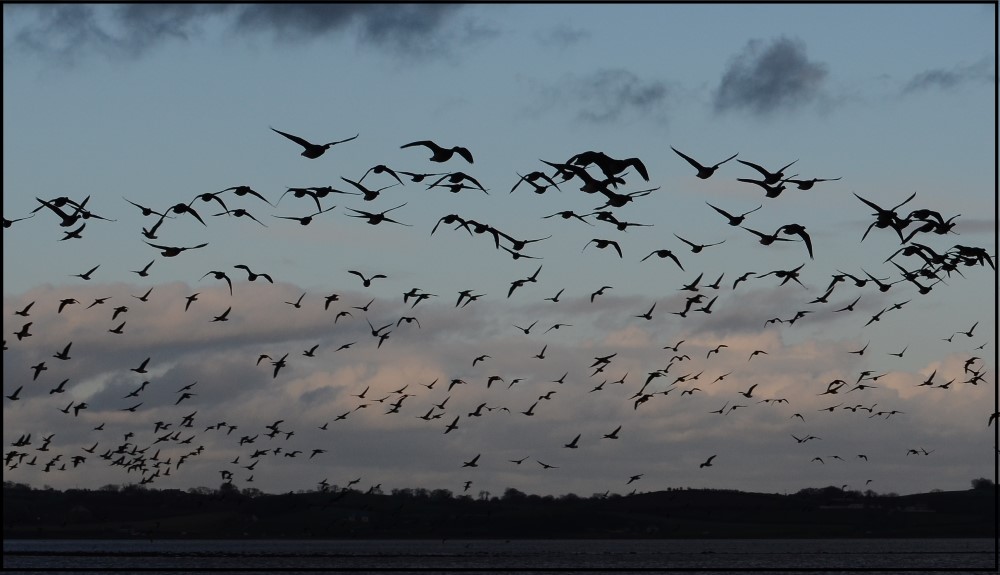
Brant Geese

The Black Brant geese (Branta Bernickla) you see along the shores of Parksville are on a remarkable and arduous journey of migration from California and Mexico to northern nesting grounds. Our beaches provide an abundant food source for the geese, which need to gain weight and strength before making another non-stop flight. A disturbance caused by something as simple as a child running on the beach can have drastic effects on the geese while feeding.
Brant can be distinguished from Canada Geese by their smaller size; dark brown body with black head, shorter neck and white collar. Unlike the honking calls of Canada Geese, the Brant call is a low, guttural "ruk-ruk" sound.
Brant breed in the north, in coastal Alaska and the Canadian Arctic on tundra and coastal islands. During winter, they are found along the Pacific coast and further south into Baja California, Mexico. Brant geese form long-term, monogamous pair-bonds and family units migrate together. Brant rarely stray far from salt water and do not come inland to graze in fields; spending winters in large flocks feeding on coastal mudflats. When Brant arrive here in the spring, they need to rest and feed on the abundant eelgrass, sea lettuce and herring roe to fuel up for the next northward migration. During migration, Brant fly in irregular bunches rather than in lines like other geese.
The biggest threat to Brant is the loss and degradation of winter habitats due to development, encroachment and disturbance. You can help to limit disturbance on the beaches by observing the signs for the seasonal no dog restriction at Parksville Bay, Columbia Beach and Little Qualicum Estuary. Parksville beaches within the Parksville-Qualicum Beach Wildlife Management Area are closed to all dogs during these times:
Rathtrevor Beach Provincial Park February 15 to April 30
Parksville Bay Beach March 1 to April 30
Brant Migration
- January - northward journey to breeding areas begins. Spring migrants work their way up the coast, stopping at bays and estuaries to refuel. Adult pairs are first to leave the wintering grounds, followed by non-breeders and last year’s young.
- March - another wildlife spectacle, the Pacific herring spawn, coincides with the arrival of the Brant in the this region. Herring roe is an abundant energy source at a critical time during migration.
- April/May - Brant make their way to Izembek Lagoon, Alaska and then to breeding grounds.
- May - arrival at breeding grounds. With a small window after ice melt and before bad weather, already paired Brant waste no time in selecting a nest site. Nests are built from sedges, grasses and down plucked from female’s breast.
- August - family groups begin journey to Alaska Peninsula.
- September - Brant numbers peak when most are at Izembek Lagoon, Alaska where they feed on extensive eelgrass beds.
- October/November - most leave Alaska on a trans-oceanic flight to wintering grounds in the lagoons and estuaries of Baja California.

Herring Spawn
In March, coinciding with the arrival of Brant to our region, the annual herring spawn is one of the natural world’s most spectacular events. These small, silvery fish fuel marine food webs and are critical to the diet of many marine birds, mammals and fishes. In addition to wildlife, herring have sustained coastal First Nations communities for years. Each year, herring migrate from offshore waters to more sheltered bays and estuaries to spawn. Male herring release milt (containing sperm) which gives the water a turquoise hue. Female herring lay eggs upon the intertidal and nearshore vegetation, which often includes eelgrass and kelp.
During the Pacific herring spawn, large flocks of Brant can be found close to shore feeding on herring eggs, an important energy source as they put on fat to complete their journey to the Arctic breeding grounds. Brant need access to quiet bays, beaches and estuaries to rest and fuel up to continue their long northward migration.

All Rights Reserved | Site by Bravenet Marketing Inc.
Legal Disclaimer/Privacy Statement
